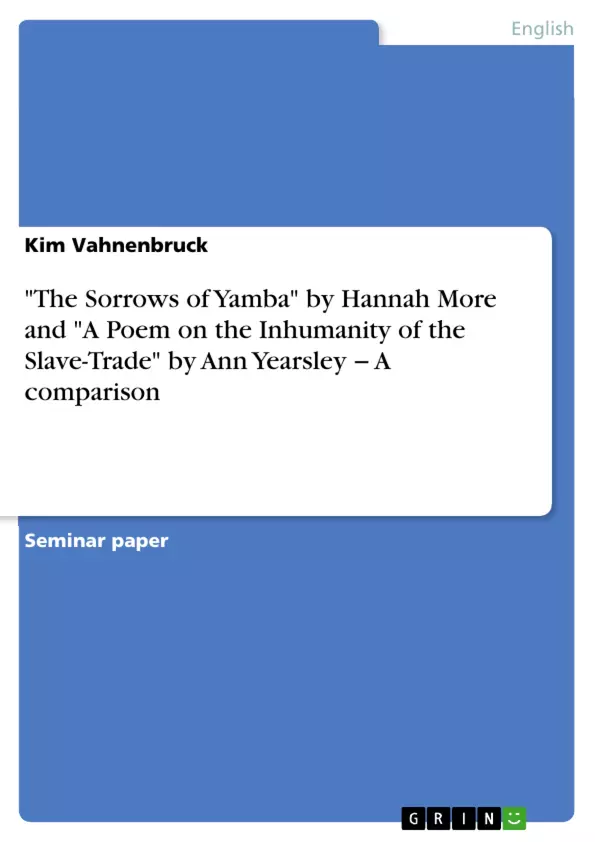The issue of slavery can be considered to be of great importance during the 18th and 19th century in Great Britain. Since the 1770s there has been the formation of an abolitionist movement because rational thinkers of the Enlightenment criticized it for violating the rights of man and furthermore for being heresy.
In 1790 the first abolition bill was presented to parliament, but it did not pass and it needed another 43 years until the abolition of slavery in the British Territories could be called a success. Especially women started to engage themselves in the abolitionist movement and tried to change the situation with means of sensibility and empathy. Therefore, I chose to analyze two poems by two very popular female anti- slavery writers, Anne Yearsley’s A Poem on the Inhumanity of the Slave- Trade (1788) and Hannah More’s The Sorrows of Yamba or the Negro Woman’s Lamentation (1795) to show the perspective of a woman on slavery.
The seminar "Romantic Women Writers" serves as a basis for this paper. I will start with an outlook on the involvement of the two women in the anti- slavery discourse, show briefly what there lives were like, through what they were shaped and influenced and what their reasons were to act against slav- ery. In the main part I will focus on the two poems and compare them with regards to similarities and differences. Both poems tell a story about a slave and his or her life in captivity. There is on the one hand the story of Yamba in Hannah More’s poem and on the other hand the story of Luco in the poem of Ann Yearsley. I chose this as a starting point for my analysis. For that, I will briefly look at the fictional characters Yamba and Luco to find out in how far they either resemble each other or differ from each other. Furthermore, I will analyze how Hannah More and Ann Yearsley use their means of sensibility and empathy and afterwards show the biggest contrasts of the two poems. Finally, I will summarize and evaluate my results in form of a conclusion.
Inhaltsverzeichnis (Table of Contents)
- Introduction
- More and Yearsley as abolitionist's
- The comparison of the two poems
- Conclusion
- References
Zielsetzung und Themenschwerpunkte (Objectives and Key Themes)
This paper aims to analyze two poems by prominent female abolitionist writers, Hannah More and Ann Yearsley, examining their perspectives on slavery. The paper focuses on comparing the poems "The Sorrows of Yamba" and "A Poem on the Inhumanity of the Slave-Trade," exploring similarities and differences in their narratives and the use of sensibility and empathy.
- The role of women in the abolitionist movement in 18th and 19th century Britain
- The use of sensibility and empathy in anti-slavery discourse
- The portrayal of the slave experience in literature
- The impact of social class and education on literary expression
- The influence of religious beliefs on abolitionist writings
Zusammenfassung der Kapitel (Chapter Summaries)
- The Introduction lays out the historical context of the abolitionist movement in 18th and 19th century Britain, highlighting the emergence of women as active participants in the struggle against slavery. It introduces the two poems under analysis and outlines the paper's methodology and objectives.
- The second chapter examines the involvement of Hannah More and Ann Yearsley in the abolitionist discourse, providing insights into their lives, motivations, and approaches to advocating for the abolition of slavery.
Schlüsselwörter (Keywords)
The main keywords and topics of this paper include: abolitionism, slavery, women writers, Hannah More, Ann Yearsley, sensibility, empathy, "The Sorrows of Yamba," "A Poem on the Inhumanity of the Slave-Trade," literary analysis, social class, religious beliefs, and the history of slavery in Britain.
- Quote paper
- Kim Vahnenbruck (Author), 2010, "The Sorrows of Yamba" by Hannah More and "A Poem on the Inhumanity of the Slave-Trade" by Ann Yearsley − A comparison, Munich, GRIN Verlag, https://www.grin.com/document/165210



